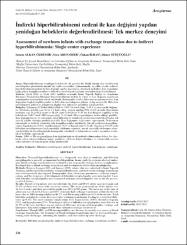| dc.contributor.author | Alkan, Senem Özdemir | |
| dc.contributor.author | Arun, Esra Özer | |
| dc.contributor.author | İlhan, Özkan | |
| dc.contributor.author | Sütçüoğlu, Sümer | |
| dc.date.accessioned | 2020-11-20T17:22:12Z | |
| dc.date.available | 2020-11-20T17:22:12Z | |
| dc.date.issued | 2017 | |
| dc.identifier.issn | 2146-2372 | |
| dc.identifier.issn | 1309-9566 | |
| dc.identifier.uri | https://app.trdizin.gov.tr//makale/TWpZNE5UY3hNUT09 | |
| dc.identifier.uri | https://hdl.handle.net/20.500.12809/7196 | |
| dc.description.abstract | Amaç: Hiperbilirubinemi yenidoğan bebeklerde sık görülen bir klinik durum olsa da bilirubin ensefalopatisi günümüzde önemli bir sağlık sorunudur. Çalışmamızda, üç yıllık sürede indirekt hiperbilirubinemi nedeni ile kan değişimi yapılan hastaların, etiyolojik nedenleri, kan değişimine bağlı gelişen komplikasyonları ve bilirubin ensefalopatisi gelişimi yönünden değerlendirilmiştir.Yöntem: Ocak 2012 ve Ocak 2015 tarihleri arasında İzmir Tepecik Eğitim ve Araştırma Hastanesi Neonatoloji Kliniğine hiperbilirubinemi nedeni ile yatan ve kan değişimi uygulanan yenidoğanlar retrospektif olarak incelendi. Demografik veriler, laboratuvar parametreleri, kan değişimine bağlı komplikasyonlar ve bilirubin ensefalopatisi gelişme sıklığı araştırıldı. Bilirubin ensefalopatisi gelişen ve gelişmeyen olgular risk faktörleri açısından karşılaştırıldı.Bulgular: Çalışmaya 27 bebek dahil edildi ve %59,3'ü erkek olup, %55,6'sı sezaryen ile doğmuştu. Ortalama gebelik yaşı 36,5± 3,1 hafta olup, doğum ağırlığı 2912,5±759 gramdı. Hastaların ortalama yaşı 34,2±54,2 saatti ve ilk 24 saatte bebeklerin % 81'ine kan değişimi yapıldığı ve bu bebeklerin %40,7'sinde ABO uyuşmazlığı, % 33'ünde Rh uyuşmazlığının neden olduğu görüldü. Kan değişimi öncesi ve sonrasında total bilirubin ve trombosit sayılarının istatistiksel farka yol açacak şekilde düştüğü görüldü (p<0,05). Kan değişimine bağlı exitus saptanmadı. Nekrotizan enterokolit ve böbrek yetmezliği gibi komplikasyonlar görülmedi. En sık rastlanan komplikasyonlar hipokalsemi (%14), trombositopeni (%7) ve hipoglisemi (%7) idi. Olguların %25,9'unda bilirubin ensefalopatisine bağlı nörolojik etkilenme saptandı, ancak nörolojik etkilenmesi olmayan bebekler ile kıyaslandığında demografik, etiyolojik ve laboratuvar verileri açısından istatistiksel farklılık saptanmadıSonuç: ABO ve Rh uyuşmazlığının kan değişimi için en sık nedenler olmasından dolayı, bu olgularda erken taburculukların önüne geçilmesi, ailelerin bilgilendirilmesi ve taburculuk sonrası yakın izlemleri ile kan değişim sıklığı azaltılabilir. | en_US |
| dc.description.abstract | Objective: Neonatal hyperbilirubinemia is a frequently seen clinical condition, and bilirubin encephlopathy is presetly an important health problem. In our study the patients who had undergone blood exchange transfusion were evaluated as for responsible etiologic factors, complications developed due to blood exchange transfusion and development of bilirü bin encephalpathy.Methods: Between January 2012 and January 2015, infants who were admitted to Izmir Tepecik Training and Research Hospital due to hyperbilirubinemia and underwent exchange transfusion were retrospectively investigated. Demographic data, laboratory parameters, exchange complications and the frequency of development of bilirubin encephalopathy were investigated. Cases with bilirubin encephalopathy were compared with non-encephalopathic ones as for the presence of risk factors. Results: Twenty-seven infants were included into the study and 59.3% of the cases were male and 55.6% of them were born with caesarean section. The mean gestational age of the infants was 36.5± 3.1 weeks and their mean birth weight was 2912.5± 759 grams. The mean age at the time of admission was 34.2± 54.2 hours and 81% of infants had exchange transfusion within the first 24 hours due to ABO incompatibility in 40.7% and Rh incompatibility in 33% of the infants. Total bilirubin and platelet counts decreased after exchange transfusion, leading to a statistical difference (p< 0.05). The most common complications were hypocalcemia (14%), thrombocytopenia (7%), and hypoglycemia (7%). Neurological effects of bilirubin encephalopathy were detected in Alındığı tarih: 24.03.2017 Kabul tarihi: 24.07.2017 laboratory data when compared with those without neurologic involvement.25.9% of the cases but there was no statistical difference in terms of demographic, etiologic and Conclusion: Though ABO, and Rh incompatibilities are the most frequently seen causes of blood Yazışma adresi: Uzm. Dr. Senem Alkan Ö zdemir, exchange transfusions, the frequency of blood exchange transfusions may be decreased by preventing early discharges, informing the families, and close follow-up after discharge. | en_US |
| dc.item-language.iso | tur | en_US |
| dc.item-rights | info:eu-repo/semantics/openAccess | en_US |
| dc.subject | Pediatri | en_US |
| dc.title | İndirekt hiperbilirubinemi nedeni ile kan değişimi yapılan yenidoğan bebeklerin değerlendirilmesi: Tek merkez deneyimi | en_US |
| dc.item-title.alternative | Assessment of newborn infants with exchange transfusion due to indirect hyperbilirubinemia: Single center experience | en_US |
| dc.item-type | article | en_US |
| dc.contributor.department | MÜ, Tıp Fakültesi, Dahili Tıp Bilimleri Bölümü | en_US |
| dc.contributor.institutionauthor | Arun, Esra Özer | |
| dc.identifier.volume | 7 | en_US |
| dc.identifier.issue | 3 | en_US |
| dc.identifier.startpage | 236 | en_US |
| dc.identifier.endpage | 241 | en_US |
| dc.relation.journal | İzmir Dr. Behçet Uz Çocuk Hastanesi Dergisi | en_US |
| dc.relation.publicationcategory | Makale - Ulusal Hakemli Dergi - Kurum Öğretim Eleman | en_US |


















